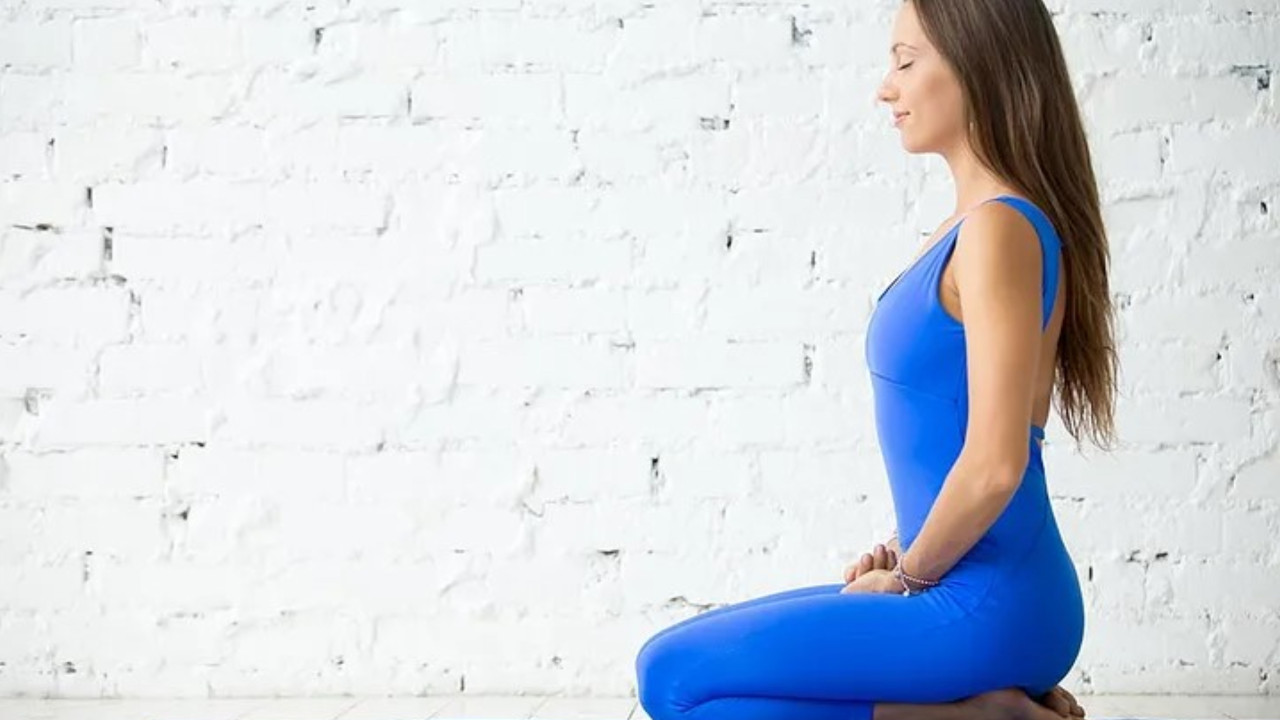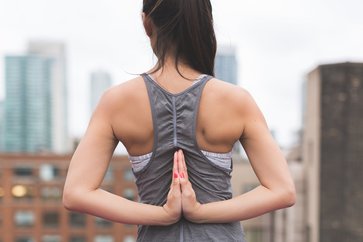Benefits Of Vajrasana ( Diamond Pose) – How To Do It?
Vajrasana is a simple yoga pose, which is ideal for beginners. It is a straightforward ‘sitting asana’ that can be easily practiced by most people. Vajrasana is also known as the Thunderbolt Pose or kneeling pose, in which a person sits on their knees for about 15-20 minutes, maintaining a steady and calm posture.
This basic asana is performed simply by sitting in a kneeling position, with the thighs resting on the calves, the body upright, and the hands placed on the thighs or knees. Vajrasana is known to improve digestion, as the pressure on the abdominal region helps stimulate the digestive organs. It also aids in calming the mind and relieving stress.
Similar to other breathing exercises or pranayamas like Anulom Vilom and Kapalabhati, Vajrasana helps promote focus and mental clarity. In addition to its physical benefits, this posture helps in cultivating mindfulness and discipline in practice. It is an excellent pose to perform before or after eating, as it supports the digestive process and promotes relaxation.
Overall, Vajrasana is a versatile and accessible asana that can be practiced by people of all ages and fitness levels, helping to enhance both physical and mental well-being.
What is Vajrasana?
Vajrasana is derived from two Sanskrit words: “Vajra,” meaning diamond or thunderbolt, and “Asana,” meaning seat or pose. The name reflects the belief that practicing this asana strengthens the body, making it as firm and unbreakable as a diamond. Hence, it is often referred to as the Diamond Pose or Adamantine Pose.
Vajrasana is one of the fourteen basic asanas that can help promote physical energy and improve the digestive system. Although it has several benefits for overall health, Vajrasana is particularly associated with enhancing digestion and alleviating digestive issues.
As a result, Vajrasana is commonly recommended in therapeutic yoga for individuals dealing with digestive problems. It is also believed to offer benefits for sexual health, making it a versatile pose for addressing both physical and digestive concerns.
What Is The Science Behind Vajrasana
Vajrasana is a meditative yoga pose that requires the practitioner to remain calm, steady, and firm. While it may appear to be a simple posture, it can be quite challenging, especially for beginners. Sitting in this pose for extended periods may initially cause discomfort or pain, and it might take time to build the endurance needed to stay in the pose for longer durations.
However, with consistent practice, Vajrasana helps strengthen both the body and mind. Over time, it can enhance your willpower, patience, and concentration, allowing you to hold the pose more comfortably and for longer periods.
From a physiological perspective, sitting in Vajrasana restricts blood flow to the legs, which stimulates improved circulation in the lower pelvic region. This increased circulation helps support the digestive system, promoting better digestion and efficiency. Regular practice of this pose not only benefits digestion but also contributes to overall physical health and mental clarity.
Steps To Do Yoga Vajrasana
Before practicing Vajrasana, it’s a good idea to start with some preparatory or warm-up poses like Ardha Shalabhasana or Shalabhasana. These poses gently stretch your muscles and help prepare your body for Vajrasana, preventing muscle strain or discomfort during the practice. Here’s a step-by-step guide on how to perform Vajrasana correctly:
Step 1: Begin by bending your knees and sitting down on your buttocks.
Step 2: Ensure that the sides of your soles are close together.
Step 3: Interlock your big toes, gently bringing your feet together.
Step 4: Maintain a straight posture by aligning your spine and neck, ensuring they are fully erect.
Step 5: Place both palms on your knees, keeping your shoulders relaxed and at ease.
Step 6: Balance your body in this position and take slow, deep breaths in and out.
Step 7: Avoid leaning your body backward or arching your spine; keep your posture firm and steady.
Step 8: Close your eyes and focus on your breathing, staying fully aware of each breath.
Step 9: Inhale and exhale deeply, allowing your body and mind to relax completely.
Step 10: Stay in this position for about 2 minutes initially. As you become more comfortable, you can gradually increase the duration to 15–20 minutes.
Note: Be mindful to follow these steps carefully for the best results. If you’re unsure about your form or experience discomfort, consult your yoga instructor. Practicing the steps properly will ensure you gain the full benefits of Vajrasana.
How To Release From Vajrasana (Thunderbolt Pose)
To release from Vajrasana, begin by gently moving both hands away from your knees. Slowly raise your knees and shift your weight onto your toes. From there, straighten your legs and transition back into a seated position.
It’s important to move slowly and smoothly when transitioning from Vajrasana to another pose, maintaining a steady rhythm. Avoid rushing the movement to prevent strain or discomfort.
Before shifting to the next static pose, take a moment to calm yourself by sitting quietly for 10-20 seconds. Focus on mindful breathing during this brief pause. This will help you stay grounded, maintain awareness, and smoothly transition to your next movement.
9 Vajrasana Variations For Yogis
1. Kurmasana (Tortoise Pose): A variation that involves lowering the torso toward the ground, bringing the arms under the legs, and extending them forward, creating a turtle-like shape.
2. Ardha Kurmasana (Half Tortoise Pose): A more accessible version of Kurmasana, where the body bends forward while keeping the arms extended in front, maintaining a gentle stretch along the back and legs.
3. Utthana Kurmasana: An advanced variation where the chest and forehead reach the ground, while the arms extend overhead, enhancing flexibility in the spine and shoulders.
4. Mandukasana (Frog Pose): This variation focuses on opening the knees wide while sitting in Vajrasana, providing a deep stretch for the inner thighs and hips.
5. Padadirasana: A seated position where the legs are stretched forward, and the feet are flexed, engaging the lower body for strength and stability.
6. Parvatasana (Mountain Pose): In this variation, the arms are raised overhead, and the body is elongated, creating a mountain-like shape that helps improve posture and flexibility.
7. Ananda Mandirasana (Bliss Pose): This variation includes placing the hands on the heart or abdomen while remaining seated in Vajrasana, promoting a sense of calm and joy.
8. Angushthasana (Big Toe Pose): A stretch in which you hold your big toes with your hands while seated in Vajrasana, helping to improve flexibility in the hamstrings and lower back.
9. Supta Vajrasana (Reclined Thunderbolt Pose): A deeper variation where you recline back while keeping the legs bent and knees on the floor, offering a gentle stretch for the spine, hips, and thighs.
These variations provide different levels of challenge and stretch, allowing yogis to enhance their flexibility, strength, and mindfulness in the practice of Vajrasana.
Top 10 Benefits of Vajrasana (Thunderbolt Pose)
1. Improves Digestion: Vajrasana stimulates the digestive organs, promoting better digestion and preventing issues like bloating, constipation, and indigestion. Sitting in this pose after meals can also aid in faster digestion by encouraging the natural flow of digestive fluids.
2. Strengthens Lower Body: This pose strengthens the legs, thighs, knees, and ankles, helping to improve overall lower body strength and stability. The continuous pressure on the legs also promotes better blood flow to the lower extremities, improving circulation.
3. Promotes Posture: Vajrasana encourages an upright spine, improving posture and alignment in daily activities. This can prevent slumping and relieve discomfort that arises from poor posture, such as shoulder and neck tension.
4. Calms the Mind: As a meditative pose, Vajrasana helps to calm the mind, reduce stress, and alleviate anxiety through focused breathing and stillness. The practice of mindfulness in this pose can promote inner peace and mental clarity.
5. Enhances Circulation: The pose improves blood flow, especially to the lower abdomen and pelvic region, supporting better circulation. Increased circulation helps to reduce swelling and discomfort in the legs and lower body, promoting overall vitality.
6. Relieves Back Pain: Vajrasana promotes proper alignment of the spine, which can alleviate mild back and lower back pain. By gently stretching the muscles along the back, it provides relief from stiffness and encourages mobility in the spine.
7. Supports Mental Clarity: Regular practice of Vajrasana improves mental focus, concentration, and clarity, making it ideal for meditation and mindfulness practices. The stillness and calm created in this pose allow for clearer thought and improved decision-making.
8. Aids in Relaxation: Vajrasana has a calming effect on both the body and mind, making it an excellent choice for unwinding after a long day or before sleep. The deep, mindful breathing practiced in this pose encourages relaxation, helping to reduce anxiety and promote restful sleep.
9. Improves Flexibility: This asana enhances flexibility in the knees, hips, and lower back, promoting greater mobility over time. It stretches and strengthens the muscles and joints in the lower body, improving overall flexibility and range of motion.
10. Supports Reproductive Health: By stimulating the pelvic region, Vajrasana benefits reproductive health and may help with issues related to the urinary and reproductive systems. The improved blood flow to this area can support hormonal balance and reduce discomfort associated with menstruation.
These added benefits make Vajrasana a versatile and accessible pose, supporting both physical and mental well-being for practitioners of all levels.
Precautions And Contraindications
Like any other asana, Vajrasana should be practiced with care and attention to safety. Here are some important precautions to keep in mind while performing this asana:
- Knee Issues: If you have knee problems or have recently undergone knee surgery, it is best to avoid Vajrasana. The pressure on the knees can exacerbate discomfort or cause strain.
- Pregnancy: Pregnant women should practice Vajrasana with caution. It is advised to keep the knees slightly apart to reduce pressure on the abdomen. Consulting a healthcare provider or experienced yoga instructor before practicing during pregnancy is recommended.
- Spinal or Vertebral Issues: If you suffer from problems related to the spine, such as herniated discs or lower vertebrae issues, it’s advisable to avoid this pose. It may place unnecessary strain on the spine, leading to discomfort or injury.
- Digestive or Abdominal Issues: Individuals with conditions like hernia, intestinal ulcers, or other digestive problems should practice Vajrasana under the guidance of an experienced yoga instructor. Improper practice could aggravate these conditions.
Always listen to your body, and if you have any concerns or health conditions, it is best to consult a healthcare provider or experienced yoga teacher before attempting Vajrasana.
FAQs
1. What are the benefits of diamond pose in yoga?
Diamond Pose (Vajrasana) helps improve digestion, reduce stress, strengthen the back and legs, and promote mental clarity. It also helps increase blood circulation to the lower body and can relieve joint and knee pain when practiced regularly.
2. What happens if we do Vajrasana daily?
Doing Vajrasana daily improves posture, enhances digestion, strengthens the core and lower body muscles, and reduces stress. It can also alleviate lower back pain and improve focus and concentration. Over time, regular practice can help in better managing anxiety and improving blood circulation to the legs.
3. Can Vajrasana reduce belly fat?
While Vajrasana itself does not directly target belly fat, it can help improve digestion and stimulate the digestive system. This may indirectly contribute to weight loss when combined with a balanced diet and other exercises. It also strengthens the core muscles, which can help tone the abdominal area.
4. Which disease is cured by Vajrasana?
Vajrasana is particularly helpful in improving digestion and relieving conditions like acidity, bloating, constipation, and indigestion. It can also aid in managing stress-related issues and is beneficial for people with knee and back pain when practiced with the right technique.
5. How long should I sit in Vajrasana?
It is generally recommended to start with 5-10 minutes in Vajrasana and gradually increase the duration as your body becomes more comfortable with the pose. Advanced practitioners can sit for up to 20-30 minutes or longer, depending on their comfort level.
6. What is the most powerful yoga pose?
There isn’t a single “most powerful” yoga pose as different poses serve different purposes, but poses like Sirsasana (Headstand), Sarvangasana (Shoulder Stand), and Adho Mukha Svanasana (Downward Dog) are considered powerful for strengthening the body, improving circulation, and promoting overall health.
7. What are the disadvantages of Vajrasana?
Vajrasana can cause discomfort for individuals with knee problems, leg injuries, or issues with mobility. If not done correctly, it may cause strain in the knees or lower back. It is important to practice the pose with proper alignment and listen to your body to avoid discomfort.
8. Which yoga is best after eating?
After eating, it’s recommended to practice gentle poses that aid digestion, such as Vajrasana or Paschimottanasana (Seated Forward Bend). These poses help improve digestion and avoid discomfort that can occur with vigorous movements after meals. Wait at least 30 minutes to an hour after eating before doing any yoga.
9. How powerful is Vajrasana?
Vajrasana is powerful in terms of its ability to aid digestion, relieve stress, improve posture, and promote mental focus. Though it’s a seated pose, its benefits for digestion and its ability to calm the mind make it highly effective in a yoga practice.
10. Who cannot do Vajrasana?
People with severe knee, ankle, or hip problems, or those who have had recent surgeries in these areas, should avoid Vajrasana. Individuals with severe arthritis, lower back problems, or other joint issues should consult a doctor before attempting the pose. Pregnant women should also avoid sitting in Vajrasana for long periods.
11. Which yoga is best for weight loss?
For weight loss, dynamic and high-intensity practices such as Vinyasa Flow, Ashtanga Yoga, or Power Yoga are considered most effective. These styles help burn calories, build muscle, and promote fat loss. Poses like Utkatasana (Chair Pose), Virabhadrasana (Warrior Pose), and Trikonasana (Triangle Pose) are also great for toning the body and aiding weight loss.
12. Is Vajrasana equal to walking?
Vajrasana is not exactly equal to walking, as it is a stationary seated pose focused on improving digestion, posture, and mental focus. Walking, on the other hand, is a dynamic exercise that promotes cardiovascular health and overall mobility. While both are beneficial for health, they serve different purposes in terms of physical movement and body mechanics.
Vajrasana is a versatile and beneficial pose for both physical and mental well-being, especially when practiced consistently. It’s a great way to improve digestion, reduce stress, and strengthen the body.


























Very Good ji